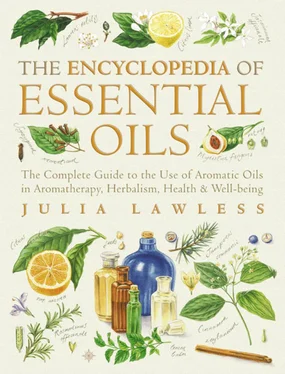OTHER SPECIESFour other varieties of pimento are found in Venezuela, Guyana and the West Indies which are used locally as spices.
HERBAL/FOLK TRADITIONUsed for flatulent indigestion and externally for neuralgic or rheumatic pain. Pimento water is used as a vehicle for medicines which ease dyspepsia and constipation since it helps prevent griping pains. It is used extensively as a domestic spice – allspice is so called because it tastes like a combination of cloves, juniper berries, cinnamon and pepper.
ACTIONSAnaesthetic, analgesic, anti-oxidant, antiseptic, carminative, muscle relaxant, rubefacient, stimulant, tonic.
EXTRACTIONEssential oil by steam distillation from 1. the leaves, and 2. the fruit. The green unripe berries contain more oil than the ripe berries, but the largest percentage of oil is contained in the shell of the fruit. An oleoresin from the berries is also produced in small quantities.
CHARACTERISTICS1. Pimenta leaf oil is a yellowish-red or brownish liquid with a powerful sweet-spicy scent, similar to cloves. 2. Pimenta berry oil is a pale yellow liquid with a sweet warm balsamic-spicy bodynote (middle note) and fresh, clean top note. It blends well with ginger, geranium, lavender, opopanax, labdanum, ylang ylang, patchouli, neroli, oriental and spicy bases.
PRINCIPAL CONSTITUENTSMainly eugenol, less in the fruit (60–80 per cent) than in the leaves (up to 96 per cent), also methyl eugenol, cineol, phellandrene and cryophyllene among others.
SAFETY DATAEugenol irritates the mucous membranes, and has been found to cause dermal irritation. Pimenta leaf and berry oil should therefore be used with care in low dilutions only.
AROMATHERAPY/HOME USE Circulation, muscles and joints: Arthritis, fatigue, muscle cramp, rheumatism, stiffness etc. ‘Used in tiny amounts … in a massage oil for chest infections, for severe muscle spasm to restore mobility quickly, or where extreme cold is experienced.’ 1
Respiratory System : Chills, congested coughs, bronchitis.
Digestive System: Cramp, flatulence, indigestion, nausea.
Nervous System : Depression, nervous exhaustion, neuralgia, tension and stress.
OTHER USESUsed in aromatic carminative medicines; as a fragrance component in cosmetics and perfumes, especially soaps, aftershaves, spicy and oriental fragrances. Both leaf and berry oil are used extensively for flavouring foods, especially savoury and frozen foods, as well as alcoholic and soft drinks.
Prunus dulcis var. amara
FAMILY Rosaceae
SYNONYMS P. amygdalus var. amara, Amygdalus communis var. amara, A. dulcis, P. communis.
GENERAL DESCRIPTIONThe almond tree grows to a height of about 7 metres and is popular as a garden tree due to its pinky-white blossom. It is botanically classified as a drupe.
DISTRIBUTIONNative to Western Asia and North Africa, it is now extensively cultivated throughout the Mediterranean region, Israel and California.
Almond Tree
OTHER SPECIESThere are two main types of almond tree – bitter and sweet. The sweet almond does not produce any essential oil.
HERBAL/FOLK TRADITIONA ‘fixed’ oil commonly known as ‘sweet almond oil’ is made by pressing the kernels from both the sweet and bitter almond trees. Unlike the essential oil, this fixed oil does not contain any benzaldehyde or prussic acid, and has many medical and cosmetic uses. It is used as a laxative, for bronchitis, coughs, heartburn and for disorders of the kidneys, bladder and biliary ducts. It helps relieve muscular aches and pains, softens the skin and premotes a clear complexion.
ACTIONSAnaesthetic, antispasmodic, narcotic, vermifuge (FFPA).
EXTRACTIONEssential oil by steam distillation from the kernels. The nuts are first pressed and macerated in warm water for 12 to 24 hours before the oil is extracted. It is during this process that the prussic acid is formed; it is not present in the raw seed. Most commercial bitter almond oil is rectified to remove all prussic acid, i.e. free from prussic acid (FFPA).
CHARACTERISTICSLight colourless liquid with a characteristic ‘marzipan’ scent (FFPA).
PRINCIPAL CONSTITUENTSBenzaldehyde (95 per cent), prussic acid (3 per cent).
SAFETY DATAPrussic acid, also known as hydrocyanic acid or cyanide, is a well-known poison. Benzaldehyde is also moderately toxic.
AROMATHERAPY/HOME USENone. ‘Should not be used in therapy either internally or externally.’ 2
OTHER USESBitter almond oil is no longer used for internal medication. Rectified bitter almond oil is used for flavouring foods, mainly confectionery; the most common uses are ‘almond essence’ and marzipan. The oil (FFPA) is increasingly being replaced by synthetic benzaldehyde in food flavourings.
Abelmoschus moschatus
FAMILYMalvaceae
SYNONYMS Hibiscus abelmoschus, musk seed, Egyptian alcee, target-leaved hibiscus, muskmallow.
GENERAL DESCRIPTIONAn evergreen shrub about 1.5 metres high, bearing large single yellow flowers with a purple centre. The capsules, in the form of five-cornered pyramids, contain the greyish-brown kidney-shaped seeds which have a musky odour.
DISTRIBUTIONIndigenous to India; widely cultivated in tropical countries including Indonesia, Africa, Egypt, China, Madagascar, and the West Indies. Distillation of the oil is generally carried out in Europe and America.
OTHER SPECIESA variety, H. esculentus, is grown largely in Istanbul as a demulcent. Another variety is also found in Martinique, the seeds of which have a more delicate scent.
HERBAL/FOLK TRADITIONGenerally used as a stimulant and to ease indigestion, cramp and nervous dyspepsia. In Chinese medicine it is used to treat headache; in Egypt the seeds are used to sweeten the breath and are made into an emulsion with milk to be used for itch. The Arabs use the seeds to mix with coffee. Widely used as a domestic spice in the East.
ACTIONSAntispasmodic, aphrodisiac, carminative, nervine, stimulant, stomachic.
EXTRACTIONEssential oil by steam distillation of the seeds. Liquid ambrette seed oil should be allowed to age for several months before it is used. A concrete and absolute are also produced by solvent extraction.
CHARACTERISTICSA pale yellowy-red liquid with a rich, sweet floral-musky odour, very tenacious. It blends well with rose, neroli, sandalwood, clary sage, cypress, patchouli, oriental and ‘sophisticated’ bases.
PRINCIPAL CONSTITUENTSAmbrettolide, ambrettolic acid, palmitic acid and farnesol.
SAFETY DATAAvailable information indicates the oil to be non-toxic, non-irritant and non-sensitizing.
AROMATHERAPY/HOME USE
Circulation muscles and joints: Cramp, fatigue, muscular aches and pains, poor circulation.
Nervous System: Anxiety, depression, nervous tension and stress-related conditions.
OTHER USESEmployed by the cosmetic and perfumery industries in oriental-type scents and for the adulteration of musk; also used as a musk substitute. Used for flavouring alcoholic and soft drinks as well as some foodstuffs, especially confectionery.
Читать дальше












